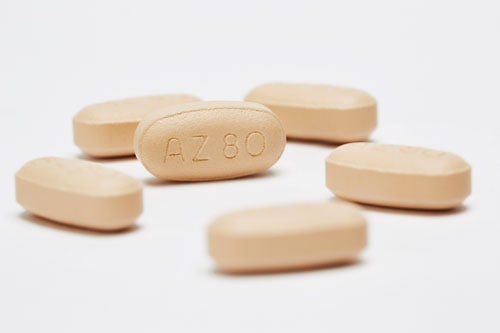
Strong sales of new lung cancer drug Tagrisso proved a balm to AstraZeneca in the first quarter, as generic competition cut away a third of its US sales.
Buoyant uptake for Tagrisso (osimertinib) in the US and EU saw the drug reach $171m in sales, up from $51m a year ago, to become AZ’s third-biggest cancer drug.
Tagrisso has just recently seen its conditional approvals in the US and EU for second-line non-small cell lung cancer (NSCLC) treatment converted to full approval, and is due to get a read-out in its first-line NSCLC trial later this year – which analysts suggest could help drive sales to around $2bn a year. It also picked up new second-line approvals in Brazil, Hong Kong and Taiwan during the first quarter.
AZ needs Tagrisso and other growth-phase drugs such as ovarian cancer therapy Lynparza (olaparib) – which rose 30% to $57m in the quarter – to help offset dramatic declines in mature products that have lost patent protection. That impact was felt particularly strongly in the US, where sales declined 34% to $1.49bn thanks largely to the launch of low-cost copies of cholesterol drug Crestor (rosuvastatin) in the latter half of 2016.
Overall, AZ reported a 12% decrease in group revenues to $5.4bn in the first quarter, which was in line with analyst expectations, and the company said it is confident that the big year-on-year declines will start to recede in the second half of this year and into 2018.
AZ has been selling off older and non-core assets left and right as it pushes the accelerator on its R&D pipeline, and says it is entering a particularly productive period that could see six new drugs launched for cancer alone between 2014 and 2020 – including Lynparza and Tagrisso.
AZ is playing catch-up in the immuno-oncology sector, but lead candidate durvalumab – a PD-L1 inhibitor – is under regulatory review as a second-line therapy for patients with locally-advanced or metastatic urothelial carcinoma (mUC), with an FDA verdict due in the second quarter of this year.
It is also expecting phase III results from a combination trial of durvalumab with CTLA-4 inhibitor tremelimumab in third-line NSCLC in the second half of the year, with data readout from a first line combination trial due in 2018. Results from a study of durvalumab plus tremelimumab in first-line head and neck cancer are also expected before the end of 2017.
Meanwhile in its targeted oncology portfolio AZ is also expecting to file BTK inhibitor acalabrutinib for B-cell malignancies later this year, with MEK inhibitor selumetinib for thyroid cancer and moxetumomab pasudotox for hairy cell leukaemia due for first regulatory submissions in 2018.
Commenting on the first-quarter performance, AZ’s chief executive Pascal Soriot said: “The pipeline continued to deliver in what we expect will be a pivotal year for AZ as we announced important developments, in particular in oncology.”
“Importantly, we anticipate the significant progress of the pipeline to continue, including our immuno-oncology and targeted treatments,” he added.




